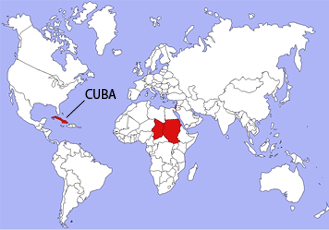
CUBA
The communist revolution in Cuba resulted in fifty years of conflict with its neighbor to the north and has yet to be resolved. On the eve of Castro’s death, great changes are coming to this small but resolute island. In what ways did Cubans benefit from Castro’s reign and how did they suffer? What is life like in one of the few countries in the world with no McDonalds, little access to the internet, and more doctors per capita than most developed nations? A behind–the-scenes look at a people, culture, and political system – from the art of fixing a 1950 Ford to life on sixteen dollars a month.
 In 2008/2009, a National Geographic filmmaker spent three months living in Cuba and shooting footage for this project. Karin Muller spoke fluent Spanish and slept in private homes, sugarcane fields, and on boats and in buses. She made friends with taxi drivers, Santera priestesses, fishermen, and farmers - and sometimes the police when they tried to arrest her. She captured stories of a remote rural town that spent five months each year preparing for a fireworks festival that turned into a war between two halves of the town - and had an unexpected conclusion. She filmed penitents who crawled six miles to the church of San Lazaro to thank the saint for a miraculous cure - in a country where religion was once outlawed by Castro himself. She learned how to make a spear gun from bicycle parts and a hundred other tricks that the creative Cubans have learned in order to survive on just a few dollars a month.
In 2008/2009, a National Geographic filmmaker spent three months living in Cuba and shooting footage for this project. Karin Muller spoke fluent Spanish and slept in private homes, sugarcane fields, and on boats and in buses. She made friends with taxi drivers, Santera priestesses, fishermen, and farmers - and sometimes the police when they tried to arrest her. She captured stories of a remote rural town that spent five months each year preparing for a fireworks festival that turned into a war between two halves of the town - and had an unexpected conclusion. She filmed penitents who crawled six miles to the church of San Lazaro to thank the saint for a miraculous cure - in a country where religion was once outlawed by Castro himself. She learned how to make a spear gun from bicycle parts and a hundred other tricks that the creative Cubans have learned in order to survive on just a few dollars a month.
Karin returned with 23 hours of hi-definition footage, interviews, and in-depth background notes on the people, the environment, history, and issues facing Cuba today. This footage is available in two forms:
PROGRAMS
For High Schools and sophisticated Middle Schools: A choice of 8 modules, each containing 5 hours of footage with a specific theme: The Black Market, Pros and Cons of Cuban Socialism, Transportation, Festivals, Entertainment, Faith&Music, Cuba's Two-Currency Economy, the recent partial privatization of Cuba's workforce, and other issues facing Cubans today. Modules also come with a cutting-edge curriculum, translated interviews, comprehensive background information, and how-to-videos and documentation.
PRICE: One-year, single classroom educational license: $250. Special price: $95.
For College/Universities and sophisticated High Schools: A professional editing package with 23 hours of digitized and sequenced footage, translated interviews, 150 pages of tape summaries, flow charts, and background information.
PRICE: One-year, single classroom educational license: $995.
An Unexpected Use for Cuban Coconuts....
They say that every sixth person in Cuba is either an informant or a member of the secret police. Whether it’s true or not, I spent a lot of time looking over my shoulder. The Cubans must be a little paranoid as well because they’ve created an entire sign language for words they don’t like to say out loud: they stroke an imaginary beard for “Fidel”, touch the tip of their tongue for “informant”, and tap one shoulder with two fingers to indicate the secret police. For the first time in my life I used the flip-out LCD screen on my hi-def video camera so that I had peripheral vision and could catch these gestures out of the corner of my eye. I always carried a Cuban five-dollar bill in my pocket, and when I saw that shoulder-tap, I would throw myself without hesitation through the nearest door. Luckily Cuba is so hot that everyone leaves their front entryway open to catch the breeze. I’d hand the bill to the first person I met and say in Spanish, “please hide me.” They’d take the money and open their fridge without missing a beat.
Virtually all Cuban fridges are the same - they’re huge, old, and sky-blue. The Cubans, with their characteristic humor, call them “coconuts”.That’s because they’re always broken, so they’re hard on the outside and empty on the inside. They make great hiding places. I’d hunker down in there for the next ten minutes, trying not to breath and listening to a muffled conversation. Eventually the door opened, and I was invited to a plate of rice and beans. I made a lot of friends that way.
Want to read more stories from the field in Cuba?
Find out how a Granny can save you on a dark Havana street at night.


